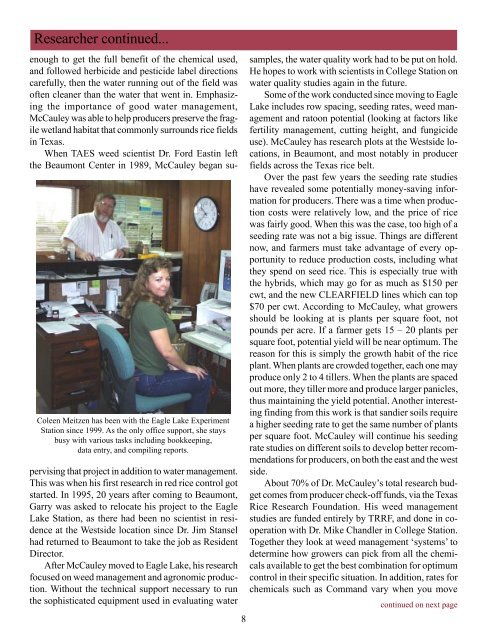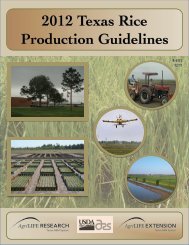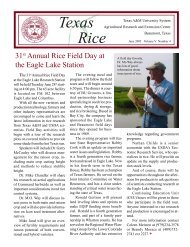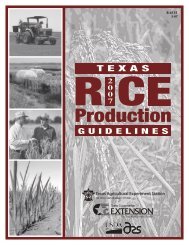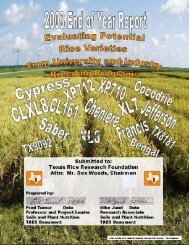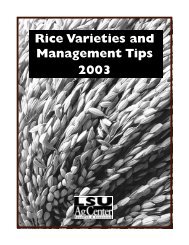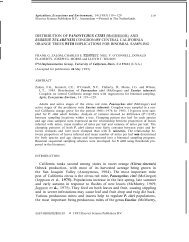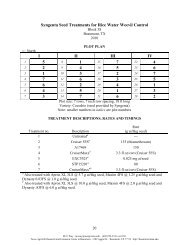Texas Rice - Texas A&M AgriLIFE Research Center at Beaumont ...
Texas Rice - Texas A&M AgriLIFE Research Center at Beaumont ...
Texas Rice - Texas A&M AgriLIFE Research Center at Beaumont ...
You also want an ePaper? Increase the reach of your titles
YUMPU automatically turns print PDFs into web optimized ePapers that Google loves.
<strong>Research</strong>er continued...<br />
Coleen Meitzen has been with the Eagle Lake Experiment<br />
St<strong>at</strong>ion since 1999. As the only office support, she stays<br />
busy with various tasks including bookkeeping,<br />
d<strong>at</strong>a entry, and compiling reports.<br />
enough to get the full benefit of the chemical used,<br />
and followed herbicide and pesticide label directions<br />
carefully, then the w<strong>at</strong>er running out of the field was<br />
often cleaner than the w<strong>at</strong>er th<strong>at</strong> went in. Emphasizing<br />
the importance of good w<strong>at</strong>er management,<br />
McCauley was able to help producers preserve the fragile<br />
wetland habit<strong>at</strong> th<strong>at</strong> commonly surrounds rice fields<br />
in <strong>Texas</strong>.<br />
When TAES weed scientist Dr. Ford Eastin left<br />
the <strong>Beaumont</strong> <strong>Center</strong> in 1989, McCauley began supervising<br />
th<strong>at</strong> project in addition to w<strong>at</strong>er management.<br />
This was when his first research in red rice control got<br />
started. In 1995, 20 years after coming to <strong>Beaumont</strong>,<br />
Garry was asked to reloc<strong>at</strong>e his project to the Eagle<br />
Lake St<strong>at</strong>ion, as there had been no scientist in residence<br />
<strong>at</strong> the Westside loc<strong>at</strong>ion since Dr. Jim Stansel<br />
had returned to <strong>Beaumont</strong> to take the job as Resident<br />
Director.<br />
After McCauley moved to Eagle Lake, his research<br />
focused on weed management and agronomic production.<br />
Without the technical support necessary to run<br />
the sophistic<strong>at</strong>ed equipment used in evalu<strong>at</strong>ing w<strong>at</strong>er<br />
8<br />
samples, the w<strong>at</strong>er quality work had to be put on hold.<br />
He hopes to work with scientists in College St<strong>at</strong>ion on<br />
w<strong>at</strong>er quality studies again in the future.<br />
Some of the work conducted since moving to Eagle<br />
Lake includes row spacing, seeding r<strong>at</strong>es, weed management<br />
and r<strong>at</strong>oon potential (looking <strong>at</strong> factors like<br />
fertility management, cutting height, and fungicide<br />
use). McCauley has research plots <strong>at</strong> the Westside loc<strong>at</strong>ions,<br />
in <strong>Beaumont</strong>, and most notably in producer<br />
fields across the <strong>Texas</strong> rice belt.<br />
Over the past few years the seeding r<strong>at</strong>e studies<br />
have revealed some potentially money-saving inform<strong>at</strong>ion<br />
for producers. There was a time when production<br />
costs were rel<strong>at</strong>ively low, and the price of rice<br />
was fairly good. When this was the case, too high of a<br />
seeding r<strong>at</strong>e was not a big issue. Things are different<br />
now, and farmers must take advantage of every opportunity<br />
to reduce production costs, including wh<strong>at</strong><br />
they spend on seed rice. This is especially true with<br />
the hybrids, which may go for as much as $150 per<br />
cwt, and the new CLEARFIELD lines which can top<br />
$70 per cwt. According to McCauley, wh<strong>at</strong> growers<br />
should be looking <strong>at</strong> is plants per square foot, not<br />
pounds per acre. If a farmer gets 15 – 20 plants per<br />
square foot, potential yield will be near optimum. The<br />
reason for this is simply the growth habit of the rice<br />
plant. When plants are crowded together, each one may<br />
produce only 2 to 4 tillers. When the plants are spaced<br />
out more, they tiller more and produce larger panicles,<br />
thus maintaining the yield potential. Another interesting<br />
finding from this work is th<strong>at</strong> sandier soils require<br />
a higher seeding r<strong>at</strong>e to get the same number of plants<br />
per square foot. McCauley will continue his seeding<br />
r<strong>at</strong>e studies on different soils to develop better recommend<strong>at</strong>ions<br />
for producers, on both the east and the west<br />
side.<br />
About 70% of Dr. McCauley’s total research budget<br />
comes from producer check-off funds, via the <strong>Texas</strong><br />
<strong>Rice</strong> <strong>Research</strong> Found<strong>at</strong>ion. His weed management<br />
studies are funded entirely by TRRF, and done in cooper<strong>at</strong>ion<br />
with Dr. Mike Chandler in College St<strong>at</strong>ion.<br />
Together they look <strong>at</strong> weed management ‘systems’ to<br />
determine how growers can pick from all the chemicals<br />
available to get the best combin<strong>at</strong>ion for optimum<br />
control in their specific situ<strong>at</strong>ion. In addition, r<strong>at</strong>es for<br />
chemicals such as Command vary when you move<br />
continued on next page


